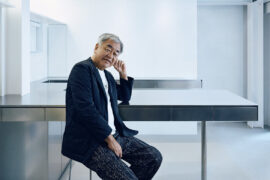The Surprising Japan exhibition at Usagi Gallery proves that Japanese design is as varied as it is unique.

Amid all the design brouhaha going on around town during the last week of November, an excited crowd piled into the snug Usagi Gallery to attend the opening of Surprising Japan, a week-long exhibition that spotlights Japanese design.
The brainchild of Design Pier’s Zsofia Illosvai, the exhibition ran from 30 November to 4 December 2016, featuring design surprises such as Hiroki Takada’s Tea Ceremony Chair, which draws inspiration from Japanese tea whisk; Kengo Kuma x More Tree’s Tsumiki, a set of wooden blocks designed for child’s play; and Kazunaga Sakashita’s Shallows, a vase that puts a thrillingly poetic spin on surface tension.
As Ilosvai notes, “I think it’s a really good mix [of] established and young [designers]. What we want to do is provide a platform for discussion, and even collaborations.”
A design panel was held on 30 November. Panelists Paolo Moscardini and Toshi Ochi of Cipango; P.C. Ee of Industry+; and Aya Kawabata delved into issues such as Japanese aesthetics, branding and the future of Japanese design.
According to Moscardini, Japanese design can be summed up as simple and detailed, possessing “something that you can’t seem to explain.” Ochi added that Japanese designers usually spend years developing a product, thus these products are usually made to last a lifetime.
Kawabata, a Tokyo-born violinist-turned designer who divides her time between the United States and Europe, said that Japanese designers usually “start with an idea or concept”, while Ee agreed, “there’s always a story behind [Japanese design]. Japanese people not only want to design something beautiful, they also design to communicate.”
The discussion segued into the question, “Do Japanese designers feel the pressure to conform to a particular style?”
“I don’t think so. I think the Japanese are very clever in adapting traditions to contemporary usage,” Moscardini said before citing Cipango’s Miyake Armor Wear Bag as an example. Ee added, “There’s soul in each product. Japanese designers don’t conform to certain shapes or approaches, but they’re also influenced by daily experiences.”
Kawabata, known for her vibrantly-hued textile works, pointed out the elusiveness of the term ‘Japanese style’. “My Japanese friends would say that my designs are very Scandinavian, but my European and American friends would say that they are very Japanese. But it is true that people expect a bit of that ‘Japanese’ [element] from you.”
Next came the question, “Are Japanese designers getting enough support from within or are they pressured to go overseas?” Ochi was quick to point out that The Chamber of Commerce in Kyoto and Kanizawa send designers to international fairs such as Maison & Objet and Salone del Mobile.
“Japanese designers are very passionate about what they do, but marketing a brand or product is a very lengthy process. It’s a very competitive market. Nendo started in Starbucks, but they have been very clever in marketing themselves,” said Ee.
Kawabata lent the discussion another perspective. “The thing I’m worried about is our traditional craft. There are so many tiny factories in Japan – all unknown yet with histories that go back centuries. Many are shutting down as the younger generation thinks it’s uncool to work there,” explained the designer.
While platforms such as Tokyo Design Week exist for Japanese designers to show their work locally, the four panelists agreed that it is often beneficial to showcase their work overseas, though Ee warned, “Designers must have very clear goals. The worst case scenario is when you get there and start questioning yourself: What am I doing here? It will end up being very costly.”
The panel concluded with the burning question: “What is the future of Japanese design?”
Moscardini’s answer was probably the most optimistic. “The world we’re living in is a pretty hard place, and technology takes that to the next level. We might be coming full circle [now], going back to designing stuff that really comes from the heart,” he said.
Click here for more information on the exhibition and artworks.
INDESIGN is on instagram
Follow @indesignlive
A searchable and comprehensive guide for specifying leading products and their suppliers
Keep up to date with the latest and greatest from our industry BFF's!

Rising above the new Sydney Metro Gadigal Station on Pitt Street, Investa’s Parkline Place is redefining the office property aesthetic.

Welcomed to the Australian design scene in 2024, Kokuyo is set to redefine collaboration, bringing its unique blend of colour and function to individuals and corporations, designed to be used Any Way!

The Parliamentary Friends reconvened at Parliament House, uniting political and professional leaders to champion architecture and design.

In a wide-ranging interview, the iconic Japanese architect joins Timothy Alouani-Roby to discuss his childhood home, the influence of Metabolism, a formative experience in the Sahara desert and a recent house by Mount Fuji.
The internet never sleeps! Here's the stuff you might have missed

Across four decades, Leone Lorrimer LFRAIA GAICD reshaped Australian architecture through strategic vision, global influence and fearless leadership.

Recognised as a winner at the INDE.Awards 2025, Barton Taylor has received The Photographer – Residential accolade. His photographic work on Cake House captures the soul of a coastal icon reimagined, blending light, texture and atmosphere into a compelling visual narrative.